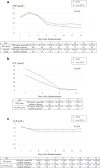Effect of dexmedetomidine on inflammation in patients with sepsis requiring mechanical ventilation: a sub-analysis of a multicenter randomized clinical trial
- PMID: 32778146
- PMCID: PMC7416813
- DOI: 10.1186/s13054-020-03207-8
Effect of dexmedetomidine on inflammation in patients with sepsis requiring mechanical ventilation: a sub-analysis of a multicenter randomized clinical trial
Abstract
Background: Administration of dexmedetomidine has been reported to improve inflammatory response in animals. We explored the effects of administering dexmedetomidine on the levels of C-reactive protein (CRP) and procalcitonin, and thus on inflammation, in patients with sepsis enrolled in a randomized clinical trial.
Methods: The DESIRE trial was a multicenter randomized clinical trial in which adult patients with sepsis were sedated with (DEX group) or without (non-DEX group) dexmedetomidine while on mechanical ventilators. As a prespecified sub-analysis, we compared CRP and procalcitonin levels during the first 14 days of treatment between the two groups. The 14-day mortality rate, albumin level, and the number of patients with disseminated intravascular coagulation (DIC) were also assessed. We used generalized linear models to estimate the differences in these outcomes between groups. We also used the Kaplan-Meier method to estimate the 14-day mortality rate and the log-rank test to assess between-group differences.
Results: Our study comprised 201 patients: 100 in the DEX group and 101 in the non-DEX group. CRP and procalcitonin levels were lower in the DEX vs. non-DEX group during the 14-day treatment period [CRP-range, 5.6-20.3 vs. 8.3-21.1 mg/dL (P = 0.03); procalcitonin-range, 1.2-37.4 vs. 1.7-52.9 ng/mL (P = 0.04)]. Albumin levels were higher in the DEX group (range, 2.3-2.6 g/dL) than in the non-DEX group (range, 2.1-2.7 g/dL; P = 0.01). The percentage of patients with DIC did not significantly differ between the groups (range, 21-59% and 17-56% for the DEX and non-DEX groups, respectively; P = 0.49). The 14-day mortality rates in the DEX and non-DEX groups were 13 and 21%, respectively (P = 0.16).
Conclusion: Sedation using dexmedetomidine reduced inflammation in patients with sepsis requiring mechanical ventilation.
Trial registration: ClinicalTrials.gov, NCT01760967 . Registered on 4 January 2013.
Keywords: C-reactive protein; Dexmedetomidine; Inflammation; Procalcitonin; Sepsis.
Conflict of interest statement
Dr. Ohta has no conflicts of interest. Dr. Miyamoto received lecture fees from Becton Dickinson and Pfizer Japan. Dr. Kawazoe received lecture fees from Hospira Japan and Pfizer Japan and a scholarship from Hospira Japan. Dr. Yamamura received lecture fees from Hospira Japan, Nipro, and Asahi Kasei and educational consulting fees from Toray Industries, CSL Behring, Teijin Pharma, and Nihon Pharmaceutical. Dr. Morimoto received lecture fees from Bayer, Daiichi Sankyo, Japan Lifeline, Kyocera, Mitsubishi Tanabe, Novartis, and Pfizer Japan; a manuscript fee from Pfizer Japan; and consulting fees from Asahi Kasei, Bristol-Myers Squibb, and Boston Scientific.
Figures
Comment in
-
[Focus general intensive care medicine. Intensive care studies from 2020/2021].Anaesthesist. 2021 Oct;70(10):888-894. doi: 10.1007/s00101-021-00976-x. Epub 2021 Jul 29. Anaesthesist. 2021. PMID: 34324037 Free PMC article. German. No abstract available.
References
-
- Nijsten MW, Olinga P, The TH. de Vries EG, Koops HS, Groothuis GM, Limburg PC, ten Duis HJ, Moshage H, Hoekstra HJ, Bijzet J, Zwaveling JH. Procalcitonin behaves as a fast responding acute phase protein in vivo and in vitro. Crit Care Med. 2000;28:458–461. doi: 10.1097/00003246-200002000-00028. - DOI - PubMed
Publication types
MeSH terms
Substances
Associated data
Grants and funding
- NA/Hospira/International
- JP17K09252/Japan Society for the Promotion of Science/International
- JP25860484/Japan Society for the Promotion of Science/International
- JP15K21535/Japan Society for the Promotion of Science/International
- JP17689022/Japan Society for the Promotion of Science/International
- JP21659130/Japan Society for the Promotion of Science/International
- JP22390103/Japan Society for the Promotion of Science/International
- JP23659256/Japan Society for the Promotion of Science/International
- JP26293159/Japan Society for the Promotion of Science/International
- JP20K07839/Japan Society for the Promotion of Science (JP)/International
LinkOut - more resources
Full Text Sources
Medical
Research Materials
Miscellaneous



